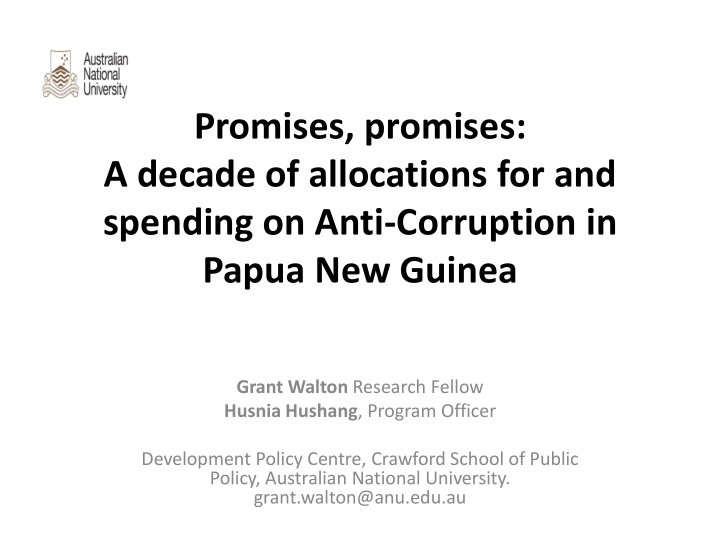



Promises, promises: A decade of allocations for and spending on Anti-Corruption in Papua New Guinea Grant Walton Research Fellow Husnia Hushang , Program Officer Development Policy Centre, Crawford School of Public Policy, Australian National University. grant.walton@anu.edu.au
Introduction • Much media coverage about anti-corruption efforts in PNG • However, still much we don’t know about the country’s anti -corruption agencies. – The Ombudsman Commission has not publicly released its annual report since 2005! • The fortunes of anti-corruption agencies are, in part, embedded in allocations and for spending on these agencies – Reveals the degree to which governments fulfil their budgetary promises, and put their money where their mouths are
Research Questions 1. How have allocations for and spending on anti-corruption organisations changed over time? 2. How does spending on anti-corruption organisations compare to other law and justice organisations, and for overall government spending?
Mind the gap: spending vs allocations
Ombudsman Commission: budgeted and actual spending in sync until 2015 Ombudsman Commission: Budgeted vs Actual Spending 25 20 Millions of kina 17.8 17.5 15 10 5 0 2008 2009 2010 2011 2012 2013 2014 2015 2016 2017 Budgeted Actual
Fraud squad: large gap between budget and spending Fraud Squad: Budget vs Actual Spending 1.8 1.6 1.4 Millions of kina 1.3 1.2 1.0 0.8 0.6 0.4 0.2 0.3 0.0 2008 2009 2010 2011 2012 2013 2014 2015 2016 2017 Budgeted Actual
FIU: spending half of allocations FIU: Budgeted vs Actual Spending 800,000 700,000 600,000 Kina 500,000 Allocation 400,000 Actual 300,000 200,000 100,000 0 2014 2015 2016 2017
Auditor General: gaps since 2015; large decline in allocations in 2017 Auditor General's Office: Budgeted vs Actual Spending 35 30 Millions of kina 25 20 17.1 16.4 15 10 5 0 2008 2009 2010 2011 2012 2013 2014 2015 2016 2017 Budgeted Actual
Taskforce Sweep/ICAC: a tale of unfulfilled promises Taskforce Sweep/ICAC: Budgeted vs Actual Spending 25 24 Millions of kina 20 15 10 5 0 2008 2009 2010 2011 2012 2013 2014 2015 2016 2017 Budgeted Actual
Most funding to Auditor General and Ombudsman Commission Spending on Five Anti-Corruption Agencies 30 25 24 Millions of kina 20 18 15 10 5 0 2008 2009 2010 2011 2012 2013 2014 2015 2016 2017 Ombudsman Commission Fraud and Corruption Actual Auditor General ITFS/ICAC FIU
Total spending less than allocations since 2012 Total Five Anti-Corruption Organisations: Budgeted vs Actual Spending 80 70 Millions of kina 62 60 50 43 43 40 39 35 30 20 10 0 2008 2009 2010 2011 2012 2013 2014 2015 2016 2017 Budgeted Actual
Comparisons
Spending:budgeted: lower for anti-corruption agencies compare to other areas of government % of Spending-to-Budget: Total Gov't Budget vs Anti-Corruption Organisations 140% 120% 100% 85% 80% 69% 60% 40% 20% 0% 2008 2009 2010 2011 2012 2013 2014 2015 2016 Total budget Anti-corruption
RPNGC: spending increases set to unravel RPNGC Budgeted vs Actual; Anti-Corruption Spending 600 500 444.7 Millions of Kina 400 300 294.2 277.3 200 100 42.9 0 2008 2009 2010 2011 2012 2013 2014 2015 2016 2017 RPNGC Budgeted RPNGC Actual Anti-corruption actual(solid)/budgeted (dashed)
DJAG: increased spending since 2011 DJAG: Budgeted vs Actual; Anti-Corruption Spending 200 180 159.4 160 152.5 Millions of kina 140 129.3 120 100 80 60 49.1 40 20 0 2008 2009 2010 2011 2012 2013 2014 2015 2016 2017 Budgeted Actual Anti-corruption actual(solid)/budgeted (dashed)
Conclusions
How have allocations and spending changed over time? • Fortunes of anti-corruption agencies have varied : – funding for Taskforce Sweep dramatically rose and fell within a short period of time, – Fraud Squad saw increases. – The Ombudsman Commission and the Auditor- General’s Office have seen some gains. • Overall both allocations and spending on key anti- corruption organizations have declined since 2013 • All agencies have suffered from promised budgetary allocations not materialising, – Acute within Taskforce Sweep and the Fraud Squad. – Overall, the difference between allocations and spending has been growing since 2012
How do anti-corruption organisations compare to other government spending? • Funding for key anti-corruption organisations has reduced in importance relative to other areas; – reductions in spending are not simply a function of smaller budgets. • Combined anti-corruption spending is now miniscule compared to two key law and justice organisations: the DJAG and the RPNGC; – (but not always the case with DJAG).
What to do? • Monitoring of budgetary allocations and spending • Further advocacy to ensure funding does not continue to fall, especially if/when an ICAC is established – Important not to overlook existing anti-corruption agencies in the rush to introduce a new one • Still more research required about why underspends and overspends occur.
Discussion Paper https://papers.ssrn.com/sol3/papers.cfm?abstra ct_id=3009987
Recommend
More recommend